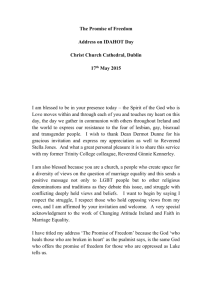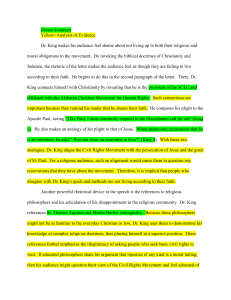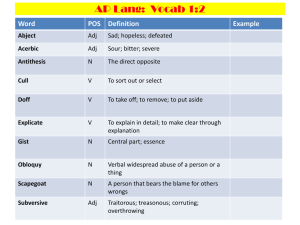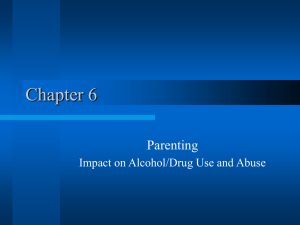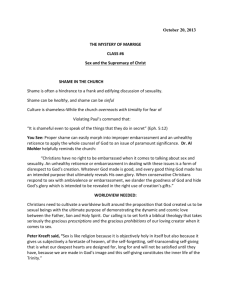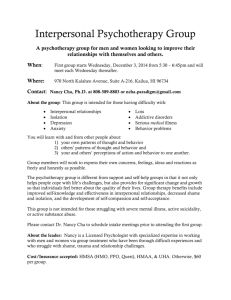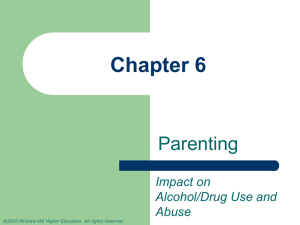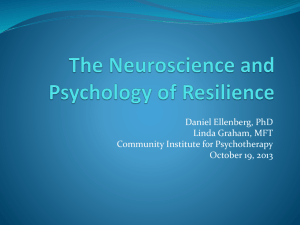Your Name - english1180asher
advertisement
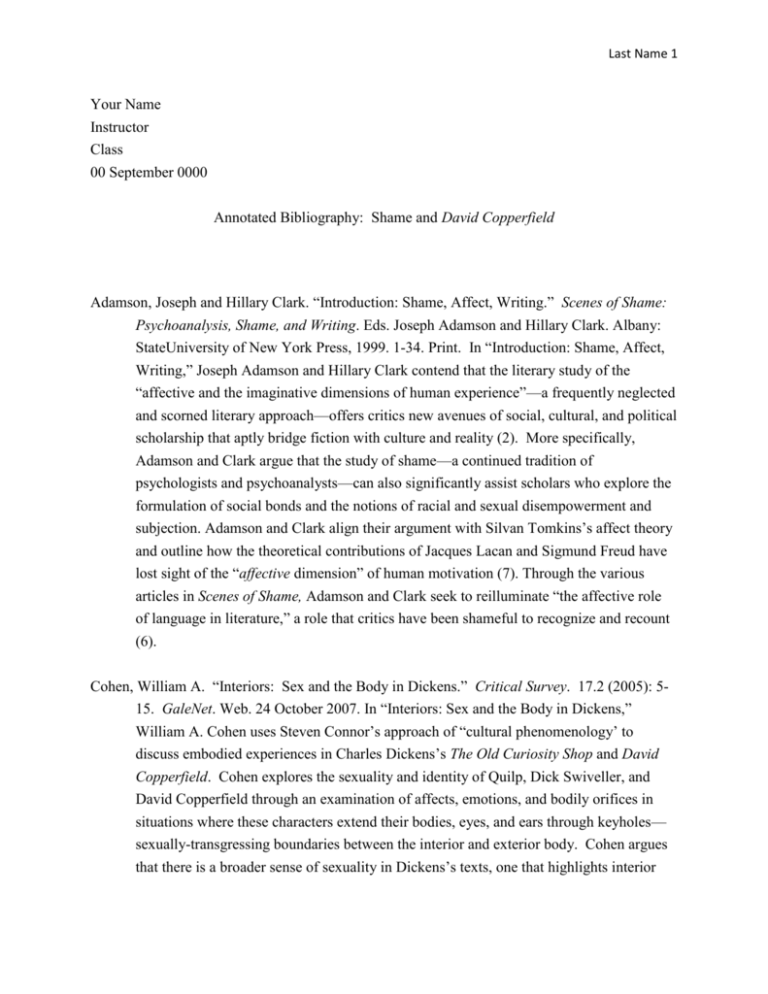
Last Name 1 Your Name Instructor Class 00 September 0000 Annotated Bibliography: Shame and David Copperfield Adamson, Joseph and Hillary Clark. “Introduction: Shame, Affect, Writing.” Scenes of Shame: Psychoanalysis, Shame, and Writing. Eds. Joseph Adamson and Hillary Clark. Albany: StateUniversity of New York Press, 1999. 1-34. Print. In “Introduction: Shame, Affect, Writing,” Joseph Adamson and Hillary Clark contend that the literary study of the “affective and the imaginative dimensions of human experience”—a frequently neglected and scorned literary approach—offers critics new avenues of social, cultural, and political scholarship that aptly bridge fiction with culture and reality (2). More specifically, Adamson and Clark argue that the study of shame—a continued tradition of psychologists and psychoanalysts—can also significantly assist scholars who explore the formulation of social bonds and the notions of racial and sexual disempowerment and subjection. Adamson and Clark align their argument with Silvan Tomkins’s affect theory and outline how the theoretical contributions of Jacques Lacan and Sigmund Freud have lost sight of the “affective dimension” of human motivation (7). Through the various articles in Scenes of Shame, Adamson and Clark seek to reilluminate “the affective role of language in literature,” a role that critics have been shameful to recognize and recount (6). Cohen, William A. “Interiors: Sex and the Body in Dickens.” Critical Survey. 17.2 (2005): 515. GaleNet. Web. 24 October 2007. In “Interiors: Sex and the Body in Dickens,” William A. Cohen uses Steven Connor’s approach of “cultural phenomenology’ to discuss embodied experiences in Charles Dickens’s The Old Curiosity Shop and David Copperfield. Cohen explores the sexuality and identity of Quilp, Dick Swiveller, and David Copperfield through an examination of affects, emotions, and bodily orifices in situations where these characters extend their bodies, eyes, and ears through keyholes— sexually-transgressing boundaries between the interior and exterior body. Cohen argues that there is a broader sense of sexuality in Dickens’s texts, one that highlights interior Last Name 2 sentimental emotion and bodily transformations that occur when materiality works its way inside the body through “sensory keyholes.” Federico, Annette. “David Copperfield and the Pursuit of Happiness.” Victorian Studies. 46.1 (2003): 69-95. Project MUSE. Web. 6 November 2007. Calling our attention to Dickens’s personal experiences and emotions as he sought to escape his own torment in writing David Copperfield, Federico considers how David’s search for happiness is never affirmed or denied in the novel. Emphasizing the affective and psychic factors of David’s experiences, Federico shows how Dickens’s notions of happiness are generally formulated by facets of Victorian liberalism, but how the acquisition of happiness cannot be limited to a collective definition that is easily schematized. Federico claims that the pursuit of happiness is “private and individual”—dependent on “affective, purely subjective measures of knowledge” (77). As Federico analyzes how David fluctuates between joy and anguish, she (without naming them so) points out aspects of Tomkins’s affect system at work in David’s experiences and even claims that our understanding of David’s emotional state is dependent upon how we are involved and affected by the text. Greenwald, Deborah F. and David W. Harder. “Domains of Shame: Evolutionary, Cultural, and Psychotherapeutic Aspects.” Shame: Interpersonal Behavior, Psychopathology, and Culture. Eds. Paul Gilbert and Bernice Andrews. New York and Oxford: OxfordUniversity Press, 1998. 225-245. Print. In this essay, Greenwald and Harder attempt to shift from recounting shame’s damaging effects on an individual—an area of shame study they view as both undeniable and exhausted—and instead claim that milder forms of shame can be beneficial in cultivating one’s adaptation skills. Arguing that shame promotes “fitness through the regulation of behavior,” Greenwald and Harder examine shame in different processes such as social bonding, competition, and mating and purport that often one’s shame behavior reveals how an individual is seeking to conform to his or her environmental and social standards (225). Last Name 3 Hornback, Bert G. “Frustration and Resolution in David Copperfield.” Studies in English Literature, 1500-1900. 8.4 (1968): 651-667. JSTOR. Web. 23 October 2007 Although this essay is a bit dated, it is important in my project because it presents a thorough, solid understanding of David Copperfield and also because it discusses David’s, as well as many other characters’, experiences and imaginations without any link to the characters’ bodies or to affect. Hornback argues that David’s mode of survival in his chaotic world is the creation of “little pockets” of love—that his relationships with Traddles or Mr. Micawber are cultivated and nurtured through their familial-like compassion and love for one another (652). Hornback claims that David and Traddles “refuse or refute experience” in their attempts to disregard the evil around them and discover ways to reorder and remake their lives (653). The traditional structure of Hornback’s essay will provide me with a foundation on which I can assert that a psychological approach—an introduction of the affect system, human adaptability and motivation, and specifically, the affect of shame—is necessary in the study of Dickens, what Hornback calls “realistic fiction” without recognition of the phenomenological aspects of real experience (652). Lynd, Helen Merrell. On Shame and the Search for Identity. New York: Harcourt, Brace and Company, 1958. Print. Claiming that shame is the experience most closely linked with identity formation, Lynd seeks to relate why shame is often not confronted—why is has disappeared from the “forefront of our consciousness” (19). Lynd articulates the differences between shame and guilt, claiming that shame experiences depend more on the loss of honor and self-respect and arguing that shame is closely linked with one’s sense of individualism. As Lynd describes the nature of shame in psychological experiments and in literary examples, she is careful to clarify that the common characteristics of shame alter with experience. Throughout her text, Lynd couples shame with trust—trust in oneself, in one’s body, in one’s society, and in others, and she shows how shame can extend from one’s interior, transform, and re-greet an individual, continuing to affect him/her in the old manner and also re-affecting him/her in a new, startling way. Another thread in Lynd’s work is her commitment to revealing how shame “sharpens one’s view” of oneself and of one’s society (215). This aspect of Lynd’s work is especially important to my analysis of David Copperfield, because it offers a way to view David’s progression as a series of shameful revelations. Last Name 4 Retzinger, Suzanne M. “Identifying Shame and Anger in Discourse.” The American Behavioral Scientist. 38.8 (1995): 1104-1114. Proquest. Web. 14 November 2007. Arguing that the complexity of emotions cannot adequately understood through the reporting of quantitative data, Retzinger offers an understanding of emotions, specifically shame, in a “moment-by-moment context.” Retzinger declares that historical texts, novels, and dialogue transcripts can be useful tools in the analysis of shame and anger, and she offers a method for uncovering the verbal references, paralinguistic gestures, and visual gestures that signal shame in discourse. By providing us with a host of possible shame examples and situations to look for in a text, Retzinger’s research parallels her theory about the complexity of emotions—each feasible lens of shame must be scrutinized for the “contextual and sequential clues” of each individual instance. (note: my article is without page numbers) Sedgwick, Eve Kosofsky. “A Poem is Being Written.” Representations. Special Issue: The Cultural Display of the Body. 17 (1987): 110-143. JSTOR. Web. 24 October 2007 Alluding to Freud’s “A Child is Being Beaten,” Sedgwick, through the analysis of her poetry (one being a long Victorian narrative about childhood shame and violence), discusses the correlation between spanking and poetry, arguing that the lyric poem— through its rhythm and ritual—is much like the spanking. Sedgwick contends that the child tends to both conceal his/her body during such humiliation, as well as identify with it while being situated in a space—much like the “immobilized space” of the lyric poem or “dilated space” of the narrative poem—that is both encircling and upon him/her (115). Aside from her exploration of the “violence-marked body,” Sedgwick’s investigation of the “legible body” in David Copperfield fittingly calls our attention to the “directionality,” “meaningfulness” and “temporality” of the body (125-26). David’s placard experience, an incident in the text which I am very interested in exploring because of its intense manifestation of shame, is described by Sedgwick as a lurking, textual shame placed on his back. She links this image to the representation of a child’s behind in a spanking, a body part that is “not under one’s own ocular control,” but a site of struggle, a means for shame-making, and a target for the “rhythms of productivity” (126).
